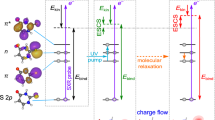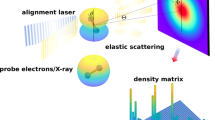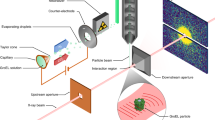Abstract
With the advent of femtosecond (fs) time resolution in spectroscopic experiments, it is now possible to study the evolution of nuclear motions in chemical and photobiochemical reactions. In general, the reaction is clocked by an initial fs laser pulse (which establishes a zero of time) and the dynamics are probed by a second fs pulse; the detection methods include conventional and photoelectron spectroscopy and mass spectrometry1–4. Replacing the probe laser with electron pulses offers a means for imaging ultrafast structural changes with diffraction techniques5–8, which should permit the study of molecular systems of greater complexity (such as biomolecules). On such timescales, observation of chemical changes using electron scattering is non-trivial, because space-charge effects broaden the electron pulse width and because temporal overlap of the (clocking) photon pulse and the (probe) electron pulse must be established. Here we report the detection of transient chemical change during molecular dissociation using ultrafast electron diffraction. We are able to detect a change in the scattered electron beam with the zero of time established unambiguously and the timing of the changes clocked in situ. This ability to clock changes in scattering is essential to studies of the dynamics of molecular structures.
This is a preview of subscription content, access via your institution
Access options
Subscribe to this journal
Receive 51 print issues and online access
$199.00 per year
only $3.90 per issue
Buy this article
- Purchase on Springer Link
- Instant access to full article PDF
Prices may be subject to local taxes which are calculated during checkout
Similar content being viewed by others
References
Chergui, M. (ed.) Femtochemistry: Ultrafast Chemical and Physical Processes in Molecular Systems (World Scientific, Singapore, 1996).
Manz, J. & Wöste, L. (eds) Femtosecond Chemistry (VCH, New York, 1995).
Zewail, A. H. Femtochemistry: Ultrafast Dynamics of the Chemical Bond (World Scientific, Singapore, 1994).
Manz, J. & Castleman, A. W. Femtochemistry. J. Phys. Chem. (spec, iss.) 97 (48), 12423–12649 (1993).
Williamson, J. C. & Zewail, A. H. Structural femtochemistry: experimental methodology. Proc. Natl Acad. Sci. USA 88, 5021–5025 (1991).
Williamson, J. C., Dantus, M., Kim, S. B. & Zewail, A. H. Ultrafast diffraction and molecular structure. Chem. Phys. Lett. 196, 529–534 (1992).
Williamson, J. C. & Zewail, A. H. Ultrafast electron diffraction. Velocity mismatch and temporal resolution in crossed-beam experiments. Chem. Phys. Lett. 209, 10–16 (1993).
Dantus, M., Kim, S. B., Williamson, J. C. & Zewail, A. H. Ultrafast electron diffraction. 5. Experimental time resolution and applications. J. Phys. Chem. 98, 2782–2796 (1994).
Ráksi, F. et al. Ultrafast x-ray absorption probing of a chemical reaction. J. Chem. Phys. 104, 6066–6069 (1996).
Tomov, I. V., Chen, P. & Rentzepis, P. M. Picosecond time-resolved x-ray diffraction during laser-pulse heating of an Au(lll) crystal. J. Appl Crystallogr. 28, 358–362 (1995).
Kim, K.-J., Chattopadhyay, S. & Shank, C. V. Generation of femtosecond X-rays by 90-degrees Thomson scattering. Nucl. Instr. Meth. Phys. Res. A 341, 351–354 (1994).
Williamson, S., Mourou, G. & Li, J. C. M. Time-resolved laser-induced phase transformation in aluminum. Phys. Rev. Lett. 52, 2364–2367 (1984).
Elsayed-Ali, H. E. Time-resolved reflection high-energy electron diffraction of metal surfaces. Proc. SPIE 2521, 92–102 (1995).
Aeschlimann, M. et al. A picosecond electron gun for surface analysis. Rev. Sci. Instrum. 66, 1000–1009 (1995).
Hargittai, I. & Hargittai, M. (eds) Stereochemical Applications Of Gas-Phase Electron Diffraction (VCH, New York, 1988).
Dibble, T. S. & Bartell, L. S. Electron diffraction studies of the kinetics of phase changes in molecular clusters. 3. Solid-state phase transformations in SeF6 and (CH3)3CC1. J. Phys. Chem. 96, 8603–8610 (1992).
Ischenko, A. A. et al. A stroboscopical gas-electron diffraction method for the investigation of shortlived molecular species. Appl Phys. B 32, 161–163 (1983).
Rood, A. P. & Milledge, J. Combined flash-photolysis and gas-phase electron diffraction studies of small molecules. J. Chem. Soc. Faraday Trans. 2 80, 1145–1153 (1984).
Ischenko, A. A., Schäfer, L., Luo, J. Y. & Ewbank, J. D. Structural and vibrational kinetics by stroboscopic gas electron diffraction: the 193 nm photodissociation of CS2 . J. Phys. Chem. 98, 8673–8678 (1994).
Williamson, J. C. & Zewail, A. H. Ultrafast electron diffraction. 4. Molecular structures and coherent dynamics. J. Phys. Chem. 98, 2766–2781 (1994).
Williamson, S., Mourou, G. & Letzring, S. Picosecond electron diffraction. Proc. SPIE 348, 313–317 (1983).
Kawasaki, M., Lee, S. J. & Bersohn, R. Photodissociation of molecular beams of methylene iodide and iodoform. J. Chem. Phys. 63, 809–814 (1975).
Baughcum, S. L. & Leone, S. R. Photofragmentation infrared emission studies of vibrationally excited free radicals CH3 and CH2I2 . J. Chem. Phys. 72, 6531–6545 (1980).
Hassel, O. & Viervoll, H. Electron diffraction investigation of molecular structure II, results obtained by the rotating sector method. Acta Chem. Scand. 1, 149–168 (1947).
Author information
Authors and Affiliations
Rights and permissions
About this article
Cite this article
Williamson, J., Cao, J., Ihee, H. et al. Clocking transient chemical changes by ultrafast electron diffraction. Nature 386, 159–162 (1997). https://doi.org/10.1038/386159a0
Received:
Accepted:
Issue Date:
DOI: https://doi.org/10.1038/386159a0
This article is cited by
-
Directly imaging excited state-resolved transient structures of water induced by valence and inner-shell ionisation
Nature Communications (2023)
-
Filming movies of attosecond charge migration in single molecules with high harmonic spectroscopy
Nature Communications (2022)
-
Jitter-free 40-fs 375-keV electron pulses directly accelerated by an intense laser beam and their application to direct observation of laser pulse propagation in a vacuum
Scientific Reports (2020)
-
Ultrafast X-ray scattering reveals vibrational coherence following Rydberg excitation
Nature Chemistry (2019)
-
Dichotomy in ultrafast atomic dynamics as direct evidence of polaron formation in manganites
npj Quantum Materials (2016)
Comments
By submitting a comment you agree to abide by our Terms and Community Guidelines. If you find something abusive or that does not comply with our terms or guidelines please flag it as inappropriate.



